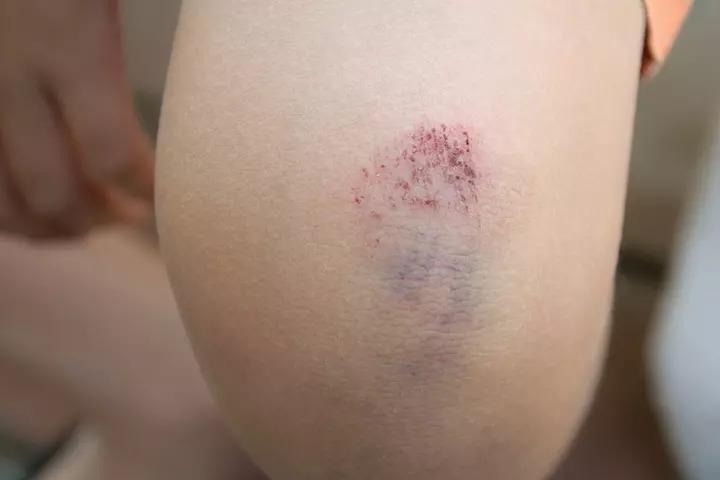Why Does My Kid Bruise So Easy

Bruising in children is caused by skin injuries that result in discoloration of the affected sites. When the skin gets bruised, the blood from the damaged blood cells collects under the skin, which causes the bruise to appear deep red, purple, blue, or black. Whether it is a toddler trying to walk or a child learning to play basketball, children often slip over and hit surfaces, bruising different body parts.
Minor bruising caused by slips, falls, or skids is common and rarely a cause of worry. It can be treated and managed at home and often fades away in a few weeks without medical intervention. However, if your child develops bruises with no identifiable cause, it could indicate an underlying medical problem or physical abuse.
Read on to learn how normal bruising differs from abnormal bruising, the signs of abnormal bruising, and its possible causes, treatment, and prevention.
What Is Normal Bruising In Children?
A bruise often leads to bleeding underneath the skin. It is usually caused by a physical impact on the body by an external object. The tissues near the affected area get compressed, damaging the blood vessels and causing them to bleed.
Bruises due to minor accidents are generally small, oval to round in shape with nondistinctive borders, and often seen in areas such as the forehead, knee, shins, elbows, and knees (1).
Here is an image of how a normal bruise looks like.
Image: Shutterstock
If the bruise on your child's body is caused by falling or skidding, it heals within three to five days. The bruise that appears red on the first day turns purple or blue in a day and gradually turns to yellowish-brown and peels away (2).
However, if you find bruises on your child's body for no apparent reason, it is a red flag, and such sudden bruises could be due to an underlying medical condition or abuse. Read on to find out the signs of abnormal bruising in children.
Signs Of Abnormal Bruising In Children
If you spot random bruises that appear in unusual locations on your child's skin, you need to be wary. Here are a few signs of abnormal bruising.
- Out-of-proportion bruises from a minor or no impact. For example, a huge bruise for a small bump
- Sudden bruises without any history of trauma or accident
- Bruises that do not heal even after weeks of occurrence
- Family history of bleeding disorders, such as Von Willebrand disease or hemophilia
- Bruises on babies who have not yet started crawling
- Occurrence of sudden bruises on unusual places, such as the ears, neck, feet, chest, buttocks, abdomen, or genitalia
- Large bruises
- Frequent nose bleeds or excessive bleeding after a dental procedure or a minor surgery
- Clustered or patterned bruises such as handprints, belt marks, or bite marks (1)
If you notice any of the above signs in your child, it is important to know the root cause. The next section covers the various reasons for abnormal bruising.
Causes Of Abnormal Bruising
As your toddler starts taking their first steps, they might trip and bump into many things, leading to bruises, or your child might come home with a new bruise after playing at school. Normal bruises are a part of childhood and are a sign that your child is trying new things.
However, if you see sudden and abnormal bruises on your child's body, it is best to know the cause behind it. The bruise could be due to any of the reasons given below.
- Child abuse: If your child gets unexplained bruises in places such as the upper arms, hands, cheeks, buttocks, and genitalia, and if the bruises look like bite marks, cigarette burns, or belt marks, it might be child abuse (3).
If abuse is ruled out, certain medical conditions might be the cause of the sudden bruising in your child. Below are the names and details of such disorders.
- Thrombocytopenia: Thrombocytopenia is a condition in which your blood has a lower than normal platelet count. It could lead to internal bleeding or bleeding underneath your skin or from the surface of your skin. It is often characterized by skin bruises and red, pinpoint, round spots on the skin (petechiae). Corticosteroids, intravenous immunoglobulins, and blood or platelet transfusions, and splenectomy are some treatment options available for severe thrombocytopenia ((4).
- Von Willebrand disease: This is a common bleeding disorder seen in approximately 1% of children. It occurs due to the lack of or abnormalities in the protein known as von Willebrand factor in the body, causing easy bruising, nose bleeding, oral cavity bleedings, and heavy menstrual periods in the case of adolescent females. Treatments options include antifibrinolytic agents and transfusion with plasma concentrates (5).
- Hemophilia A and B: These are bleeding disorders linked to the mutations in genes responsible for the production of coagulation factors VIII and IX. If not managed in early infancy, they can lead to chronic diseases or lifelong disabilities. Children with hemophilia show abnormal bruising or bleeding, bleeding in the joints, bleeding after incisions or losing a tooth, and frequent nosebleeds. Treatment includes infusing commercially prepared clotting factors regularly (6).
- Leukemia: This is a common cancer of the blood, wherein the cancerous cells grow in the bone marrow and get circulated into the blood. Bruising and bleeding are some of the common symptoms of leukemia. The bruises appear in unusual places, such as the face, buttocks, ears, chest, and head. These bruises last long and even grow in size. Other leukemia symptoms include fatigue, pale skin, shortness of breath, and loss of appetite (7), (8).
- Childhood IgA Vasculitis: Formerly known as Henoch Schonlein Purpura, this blood disorder can occur in children of any age, but the symptoms peak at four to six years. This condition occurs due to abnormalities in immunoglobulin A (IgA), a major antibody that is present in the mucosal secretions and serves as the first line of defense against invasion by pathogens. Symptoms include sudden onset of bruises, purpura, mucosal hemorrhage, and petechiae. Most IgA cases in children improve on their own and do not require any specific treatment (9).
- Factors II and V deficiency: Sudden bruising and bleeding disorders occur in children when they are born with deficiencies of coagulation factors prothrombin (FII) and proaccelerin (FV), which serve an important role in blood clotting. The deficiency of these factors in the body is characterized by bleeding gums, nosebleeds, sudden bruises, and prolonged bleeding after an injury. It may be treated through plasma transfusion (10) (11).
- Vitamin K deficiency: Bruising and bleeding in children can also occur due to vitamin K deficiency. Vitamin K proteins play an important role in coagulation, bone development, and cardiovascular health (12). Vitamin K transport across the placenta is generally poor in babies, so watch out for symptoms such as bruises around the head and face and bleeding from the nose. According to the National Institute of Health, the dietary intake of Vitamin K for children should be 30mcg–60mcg (13). Treatment options include vitamin K shots or dietary intake.
Apart from the above causes, medicines, such as aspirin, and some antibiotics can also cause bruises in children (14).
When To See The Doctor?
If you notice a recurring pattern of bruises in your children, with no known cause, it is best to consult your pediatrician. Take your child to the doctor if you notice any bleeding disorders or see any of the below signs.
- Unexplained bruises in a recurring pattern
- Painless bruises
- Random bruises without signs of injury
- Black bruises on the legs or other unusual places
Besides a physical examination, your doctor might prescribe tests, such as a complete blood count, peripheral blood smear, and bleeding time, to determine the functioning of the clotting factors and diagnose bleeding disorders.
Treatment Of Bruises In Children
If the bruises are due to minor trauma, they could be treated at home by applying an ice pack or prescribing over-the-counter medication to reduce pain and swelling.
Random bruising can also be caused if your child is being subjected to abuse that you are not aware of. If your child has to spend time with a babysitter or at the daycare, make sure your child is in safe hands. Still, if you find suspicious bruising, it is best to consult child welfare authorities, as childhood abuse is deeper than the bruise.
If the bruises are abnormal and your child is diagnosed with bleeding disorders, follow the treatment prescribed by your doctor.
Prevention Of Bruising In Children
When your child is growing up and exploring the world, it might not be possible to prevent bruising, as it is a part of the growing-up process. However, you can help your child avoid bruises to some extent by instructing them to wear shin, shoulder, knee, and thigh guards.
Most bleeding disorders need to be managed with the utmost care. If your child is diagnosed with a disorder, talk to your health care provider and gather as much information as possible. Also, explain the disorder to your child, and tell them the importance of taking certain precautions.
1. What does bruising from leukemia look like?
Bruises caused by leukemia occur in unusual places, such as the back and hands. Besides, multiple bruises usually occur without any prominent cause or reason (7).
2. Why are my child's legs always bruised?
It isn't unusual for active children to get bruised frequently. Children usually get bruises due to bumps and falls. However, you should speak to a doctor if you see multiple bruises without apparent cause.
3. Which of the body locations are areas of normal bruising on a child?
According to experts, accidental bruising in active children can be commonly seen on the knees, elbows, forehead, nose, chin, and head (12).
Bruised skin is common in children as they fall and hurt themselves, especially when young. Due to impact from a fall, the tissues and blood vessels under the skin might get compressed and damaged, leading to discoloration of the skin and a bruised appearance. If you notice any bruising that appears on the skin for no reason or does not resolve for days, you should seek a healthcare professional's advice. Furthermore, any abnormal marks, such as bite marks, finger marks, or other abnormal items, must be reported promptly, particularly for children who spend time with caregivers or at daycare centers.
Key Pointers
- Normal bruising and bleeding underneath the skin are commonly caused when children slip over or hit surfaces.
- It is worrisome if no apparent cause can be identified or is at unusual places such as ears, neck, buttocks, or genitalia.
- Abnormal bruising may indicate child abuse or an underlying health issue such as blood clotting disorders and requires medical attention.
References:
MomJunction's articles are written after analyzing the research works of expert authors and institutions. Our references consist of resources established by authorities in their respective fields. You can learn more about the authenticity of the information we present in our editorial policy.
Was this information helpful?
![]()
![]()
The following two tabs change content below.
![]()
Dr. Ritika Shah is a certified lactation counsellor from iNational Health Care Academy, Singapore and a dental surgeon with more than seven years of clinical experience across various cities in India. She did her graduation in Dentistry from KM Shah Dental College. During her clinical practice, pediatric dentistry was her particular area of interest, and she constantly thrived to inculcate... more

Dr. Elna Gibson is a general pediatrician. She did her MBChB and specialization as a pediatrician in South Africa at the University of Pretoria. She obtained MMed Pediatrics (masters) with distinction in 1993. As a young specialist, Dr. Gibson spent some time in the Netherlands, and then settled in the Vaal Triangle where she has practiced for 25 years. She... more
Source: https://www.momjunction.com/articles/abnormal-bruising-in-children-when-to-worry_00668470/

0 Response to "Why Does My Kid Bruise So Easy"
ارسال یک نظر